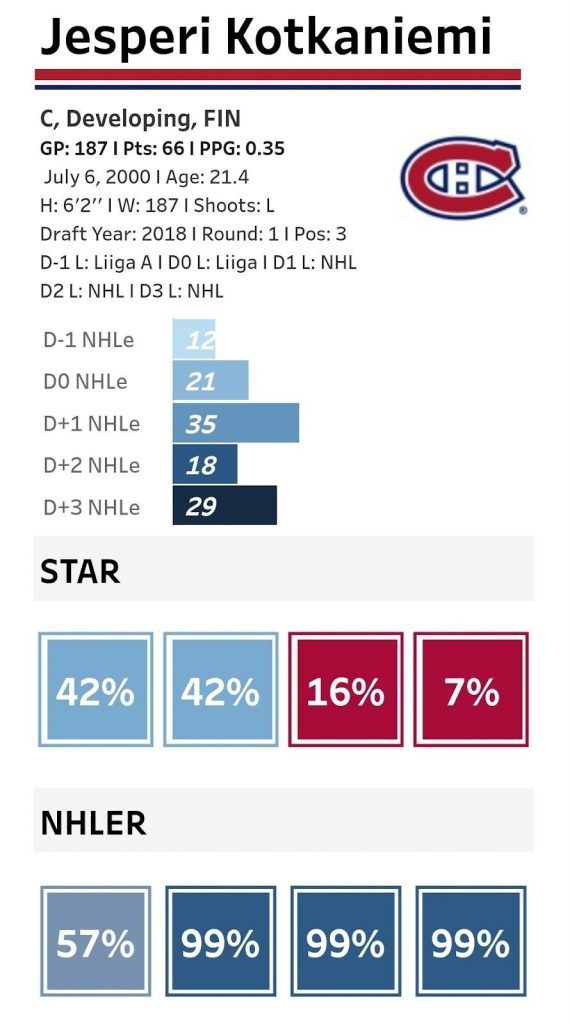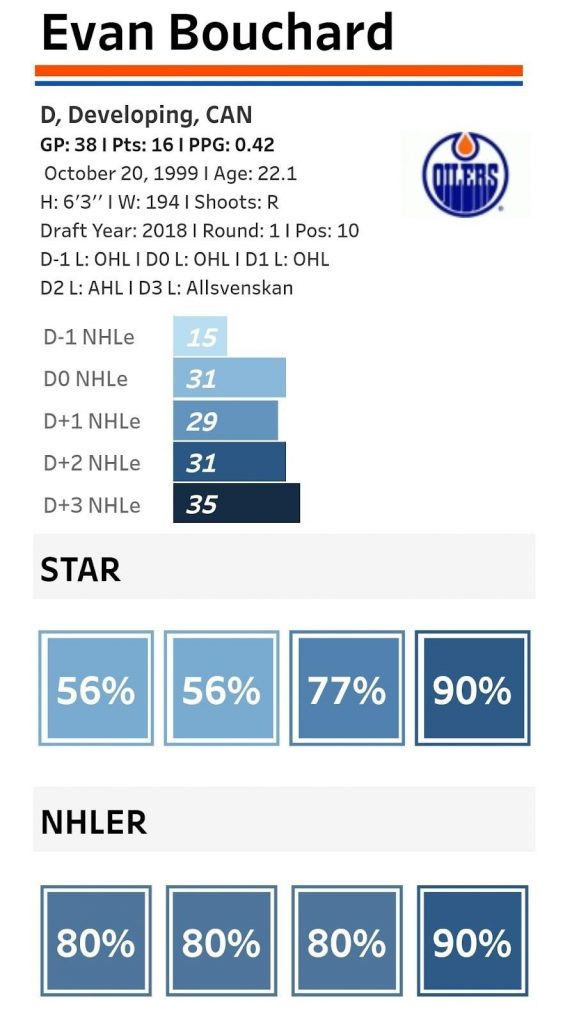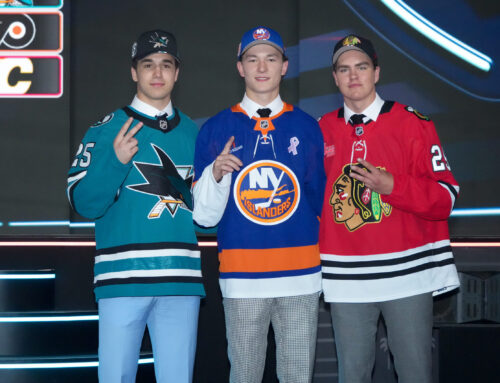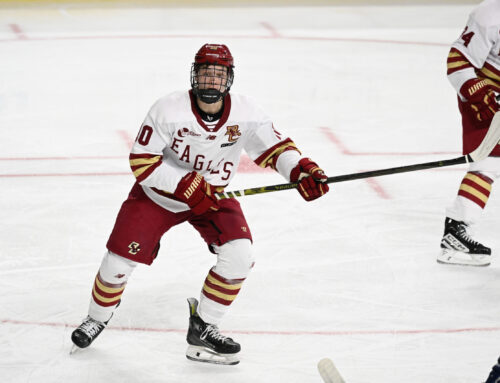Welcome back to The Journey, where we follow hockey prospects and their paths to the NHL, providing fantasy predictions and analysis along the way. This week, we'll begin a retrospective on the 2018 NHL entry draft providing updates on performance since the draft, future outlooks, and pick grades.
The reason for starting with the class of 2018 is that the three-year gap allows a clearer picture to emerge about who these players are and how their careers might progress from here. It's also recent enough that this group contains a solid mix of established NHLers, players just breaking into the league, and prospects still toiling in juniors. There are also some picks that already didn't pan out.
An important concept for this series is Breakout Threshold (BT), a more precise version of the 4th year breakout theory. The basic idea is that historical trends have shown with roughly 80% accuracy that average-sized players (5-10 to 6-1 and 170 to 210 lbs) tend to take 200 NHL games played (GP) to reach their prime production years. Players smaller or bigger than that usually take twice as long, 400 GP, to hit their upside. Keeping in mind that 20% of players don't end up following this rule, BT can be an extremely useful metric for ballparking when a player's breakout year will happen and buying low on them while they're still overlooked.
In our assessments, we'll use the terminology from Hockey Prospecting:
- Star Producer → 0.7 career points-per-game (ppg) for Forwards (F) & 0.45 ppg for Defencemen (D)
- Average Producer → Less than 0.7 career ppg for F & 0.45 ppg for D
- Developing → A prospect with insufficient NHL data for an accurate sample size
- Bust → Not playing in the NHL/minimal production
This week, we'll kick things off by looking at the first 10 picks of the 2018 draft.
(Stats were taken before the start of Wednesday’s games.)
1st (BUF) – Rasmus Dahlin
121 pts in 219 GP (0.55 ppg)
Verdict: Star Producer
Dahlin is one of those players who have been around forever but are still really young, as he is only 21 and already in his fourth season. He is already considered one of the most dynamic blueliners in the game. He's taken a similar path to Aaron Ekblad, another defenceman taken first overall, who is playing in his eighth NHL season but is only 25 years old.
Last year was a write-off for that entire Sabers team, Dahlin included. But his historic rookie year in 2018-19 (44 pts in 82 GP), in which he scored the highest total by an 18-year-old defenceman since Phil Housley, was no fluke. His sophomore campaign (56-point pace) already proved that. Last year, Dahlin still managed a 34-point pace in the shortened campaign as a 20-year-old, which gave him a star potential of 96% in a down year.
With his slow start again this year, there was perhaps a brief window to capitalize on the Buffalo Tire Fire™. Hats off if you managed to pry him away from a nervous GM. But he hit his Breakout Threshold of 200 games at the start of this season and now has eight points in his last nine games. That window is shut. Dahlin will continue getting all the ice and powerplay time he can handle during this post-Eichel rebuild, and his point totals will only climb from here.
2nd (CAR) – Andrei Svechnikov
160 pts in 22 gp (0.71 ppg)
Verdict: Star Producer
Can’t kvetch about Svech (had to): he hits, he shoots, he scores. He’s the kind of player you build a dynasty team around. Like Dahlin, he made the Hurricanes right after being drafted, so he recently passed his BT too. He’s a point-per-game since then on top of three shots and 1.7 hits per game.
His PDO (luck) is a tad high but other metrics like ice time and shooting percentage (S%) are normal. He’s playing primarily with Sebastian Aho and Seth Jarvis (!), his deployment is preferential, and he drives play and maintains possession. What more could you want from a 21-year-old in the NHL? Superstar.
3rd (MON) – Jesperi Kotkaniemi
69 pts in 191 GP (0.36 ppg)
Verdict: Developing
The first two were slam dunks but Kotkaniemi has a perplexing case of Borgstrom’s Disease: a highly-touted scoring prospect rushed to the NHL, forced into a defensive role, then punished with low ice time and poor deployment. Carolina bet big this summer on the beleaguered Finn returning to form. Until his recent hot streak (five pts in six GP), however, Kotkaniemi had managed just two points in 15 GP with his new club.
Can he figure things out and become anywhere near the calibre of player he was drafted as? The picture remains murky for the moment but the odds are increasingly lengthy. After struggling for two consecutive seasons in Montreal, Kotkaniemi's star potential is down to 7%.

But he's getting a fresh start with a new team and hits his BT in nine games. If this recent burst of production continues as he further acclimates to Rod Brind'Amour's system, perhaps Kotkaniemi can still become the scoring star that Montreal saw (and then nearly extinguished) in him back in 2018. Or else maybe he caps out in the 40–50-point range and becomes a reliable 2nd or 3rd center behind Aho.
The chart below provides a snapshot of how things are going: he's currently being heavily sheltered by the Canes with the most offensive zone starts (OZ%) on the team (his circle is way to the right) and usage against relatively low quality of competition (bottom third). His icetime is minimal but he's doing well with it, posting the best play-driving numbers on the team in limited action (darkest blue). Hopefully for Kotkaniemi owners, what we've seen from him over the past handful of games is him hitting his BT and beginning to realize his potential. At his best, Kotkaniemi is a rangy workhorse who throws his body around and is a threat to either thread the needle or bury the puck himself.

4th (OTT) – Brady Tkachuk
136 pts in 214 GP (0.64 ppg)
Verdict: Average Producer (but fantasy beast)
Tkachuk hasn't really been snakebitten this year, as his shooting percentage is normal. But he definitely has been bitten.
Really though, three years out and he's looking pretty damn good as a top pick in this draft—unlike Kotkaniemi and a few of the other names in the top ten. He's already the Senators captain, he's the second coming of Alexander Ovechkin in bangers leagues, and he's likely another couple hundred games from hitting his top gear as a bigger player (6-4, 210 lbs).
Tkachuk is already dominating the other team's best players and getting all the offensive opportunities he can handle at both even strength and with the man advantage as the central pillar in Ottawa's attack. As the other young Senators continue to develop alongside him, Tkachuk's offensive numbers will continue to improve, almost certainly pushing past the 0.7 career ppg mark into stardom. He should comfortably be one of the top multicategory options in fantasy for the next decade or more.
5th (ARI) – Barrett Hayton
10 pts in 50 GP (0.20 ppg)
Verdict: Developing
The Coyotes might be having a historically bad year (#PainforShane) but at least they're finally giving Barrett Hayton some ice time, right? He's played 15+ minutes per game, including time on the powerplay, while skating at 5v5 alongside Arizona's top F stars, Clayton Keller and Phil Kessel. So far he's rewarded his long-suffering dynasty owners with less than a shot per game, a solitary power-play point, and a 14-point pace on the season. Not great.
Hayton is still 150 GP away from his BT but has a low 5%-star potential and looks increasingly like he'll round out as an Average Producer in the Coyotes' middle six. One positive note from this season is that Hayton is winning 51% of his faceoffs with an average of 7.7 wins per game. Impressive numbers at the dot for such a young player. This might be a case of him being a better real-world than fantasy player, though. Move on if you can.
6th (DET) – Filip Zadina
44 pts in 108 GP (0.41 ppg)
Verdict: Developing
Zadina hasn't been scoring much so far but has consistently had some of the best play-driving and possession metrics on the Red Wings this year. He's seeing power-play time and playing well as part of Detroit's strong second line. It's just a matter of time (say, 90 more NHL GP) until he ups his current 30-point pace into the 60s with an emphasis on syrupy sweet goals like this:
The next two seasons will be critical for Zadina's development. At this point, his career progression looks a lot like those of Kyle Okposo and Jared McCann—guys who step up when needed but generally provide secondary scoring. But Zadina was a prolific goal scorer in junior (44 goals in 57 QMJHL GP) and likely possesses more offensive upside than those comparables.
That upside should begin to show itself partway through next season, though his points ceiling is probably lower than the Red Wings initially hoped. Taking Zadina at #6 will always be a tough selection to defend given the star power selected after him, but in Detroit's defence most of that star power was on defence. If they were set on taking a forward, Zadina still looks like one of the more dynamic forwards available in this draft after Svechnikov.
7th (VAN) – Quinn Hughes
113 pts in 151 GP (0.75 ppg)
Verdict: Star Producer
It's hard to believe that Hughes slipped to 7th in this draft. There's an argument to be made for him going first overall now in a redraft. He has the highest scoring output of any player in the class, forwards included, and he's still 50 games away from reaching his BT. That's an incredibly strong resume. Vancouver's having a tough go of it in the early going but Hughes is still pacing for 60 points. When this team starts putting everything together, watch out.
There is a major red flag here, though: Hughes puts up very, very few peripherals. He put up 41 pts in 56 games last year, including 19 power-play points, yet finished 154th overall in cumulative value in my deep 20-team dynasty league. His lack of shots (under two/game), hits (18 on the year), and even blocks (0.78/game) significantly impeded his ranking. Depending on your league's categories, there's likely a big gap between his actual and perceived value. Do with that what you will.
8th (CHI) – Adam Boqvist
35 pts in 88 GP
Verdict: Developing (looking good but he's an injury risk)
The major piece back to Columbus in the Seth Jones deal, Boqvist will conceivably get the opportunity and support to realize his potential. Injuries are the red flag here as he has already had a broken wrist, injured shoulder, and several other undisclosed upper and lower body ailments in his short pro career. Another red flag is that Zach Werenski is the top blueline dog in Columbus and is signed long-term.
Regardless, if Boqvist can stay healthy and see meaningful powerplay time and offensive deployment, he has strong potential to become a star (61%). While stay-at-home types like Fedor Tyutin and Jordan Leopold were comparables in his draft year, his performance since then has him on a similar trajectory to legends like Ed Jovanovski, Scott Stevens, and Mathieu Schneider. Boqvist has done extremely well possession-wise so far this season playing a very sheltered role and seeing time on the Blue Jackets' top powerplay. Give him another couple seasons to reach his BT before jumping to any conclusions.
9th (NYR) – Vitali Kravtsov
4 pts in 20 GP
Verdict: Developing
A lot of digital ink has already been spilled on the rift between Kravstov and NYR. Basically, he didn't see a meaningful spot for him in their top six any time in the near future and went back to Russia. Perhaps Chris Drury was mean to him. Either way, he's playing – and playing well – in the KHL for Traktor Chelyabinsk (6 pts in 8 GP) for now until the Rangers can work out a suitable trade. There are apparently lots of interested teams.
Here’s a glimpse into why people are still excited about this guy:
Last year during a 20-game stint with the Rangers, Kravtsov was clearly not put in a position to succeed. He was given 12 minutes a night alongside Brett Howden and *checks notes* Kevin Rooney and had almost no power-play time. His four points and 23 shots kind of check out given that context. So it remains difficult to project the kind of player he could become at the NHL level assuming he returns. The Hockey Prospecting model suggests Andrew Mangiapane, Kevin Labanc, and Michael Frolik as comparables and gives him a 1% chance of becoming a star in the NHL. That's not the rosiest outlook for a former 9th overall pick. If he can be had for cheap and you have the space, Kravtsov might be worth a gamble. Otherwise, keep your money and look elsewhere.
10th (EDM) – Evan Bouchard
17 pts in 41 GP
Verdict: Developing (looking like a Star Producer)
Bouchard has finally arrived, and he's legit. There are still holes to his game and he makes the occasional sloppy turnover, but he's scoring (45-point pace), his possession metrics are strong, and he hasn't even been given the keys to the Oilers' formidable power play yet (only 14% of available time). It's probably too late but get a hold of Bouchard stocks right now wherever you can. They're heading straight up. Sure, Tyson Barrie is signed for two more years but Bouchard will likely be breathing down his neck by the end of this year for those prime offensive minutes.

Thanks for reading! Follow me on Twitter @beegare for more prospect content and fantasy hockey analysis.






 VAN
VAN L.A
L.A CBJ
CBJ NYI
NYI PHI
PHI COL
COL ANA
ANA PIT
PIT
